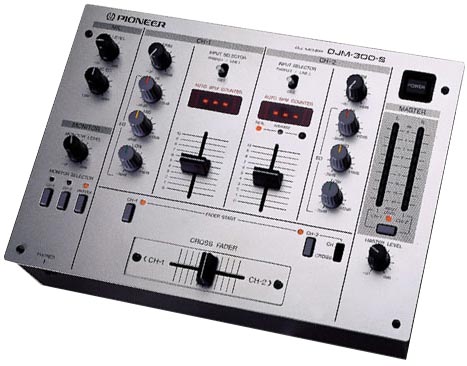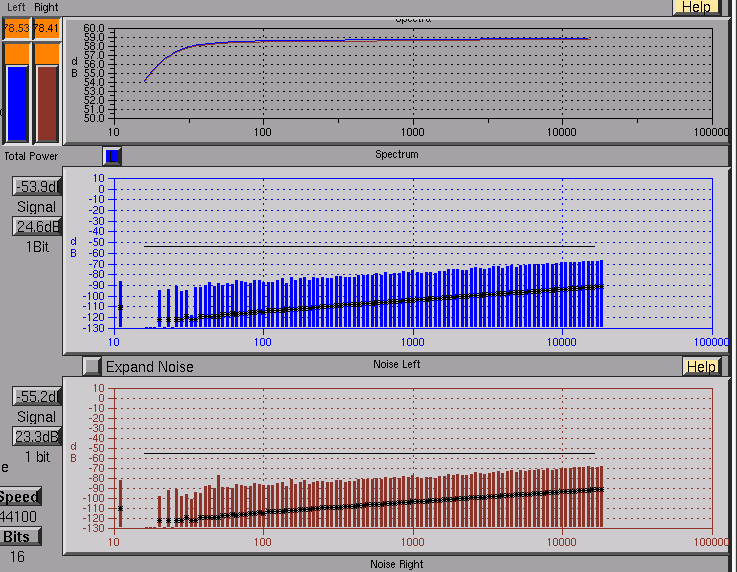
Chris Close
christopher dot close at g mail dot com

I
was bored tonight, so I thought I would send some test audio through
my DJM-300 DJ Mixer using an M-Audio Transit USB sound card: 
DISCLAIMER: I don't assert that these tests are 'real world' results. I mostly did this to ascertain where the EQs cut in on this mixer. Don't take the response and noise values as gospel.
While this card is capable of doing 96kHz/24bit, I performed these tests in 44.1kHz/16bit mode. It would have been possible to do the tests in 48kHz/24bit if I was to find the correct test file for the xsndtest program, however the site was down. Full-duplex 96kHz operation is not supported by the device.
The program I used to perform the tests is xsndtest. This program runs under Linux.
The result below is from looping the Line Output from the sound card directly back to the Line Input of the sound card (used a standard 3.5mm stereo cable). I had to adjust the playback/recording levels appropriately in the software mixer for the sound card in order to get the best results:

The card gives pretty good results on its own. I noticed that if I put the cable near the powered on DJM-300, some extra noise would be shown in the graphs. This test is when the mixer is turned off.
The graphs shown are in a logarithmic scale. For your reference:
The notch inbetween 10 and 100Hz on the spectrum is 31.6Hz.
The notch inbetween 100 and 1000Hz on the spectrum is 316Hz.
The notch inbetween 1000 and 10000Hz on the spectrum is 3162Hz.
The next set of results are from sending the Line Output from the sound card into the 'Line 2' channel on the mixer (using a stereo 3.5mm -> 2 x RCA cable). One of the main outputs from the mixer is then sent to the Line Input on the sound card. The input level, and the expected output level, for the DJM-300 are both much higher than that of the 'line' level expected by the sound card. So once again, I had to adjust the playback/recording levels appropriately in the software mixer for the sound card in order to get the best results. I also had to set the 'Trim' on Channel 2 all the way up. The 'Master Volume' was set to about 2 o'clock. This results in the output meter on the mixer showing a volume of about 0dB.
Here is the result of the test with Channel 2 fader up 100%, Channel 2 at 0%, the cross-fader disabled and the EQ's all at 12 o'clock:

The frequency response is generally quite good, bar the dip at the start. An extra 15-18dB of noise seems to have been added to the circuit compared to the Transit on its own. The output level graph at the top shows the signal flattening out to around 59dB. We will be using this as the base for the rest of our tests.
For the next set of tests, I have omitted the noise statistics so the page doesn't blow out too much. If you want to see the full result, click on the image.

You can see the bottom of the drop just before 100Hz. It looks to me to be at about 69Hz... sexy. Looks to be about a 27dB attenuation (softening).

It's a bit harder to quantify the drop in this one. I'm guessing about 10dB attenuation.

I've included the 'flat' response for comparison.

For anyone crazy enough to be turning up their bass this far, it looks like it's peaking at approx 48Hz, with 6dB amplification (compared to flat). I haven't tested it with the EQ all the way over for some reason :).

You can see the bottom of the drop right at 1000Hz. Looks to be about a 27dB attenuation again.

Looks to be about 8dB attenuation compared to the flat response. The difference between the bass and the 1000Hz response is about 6dB, as the bass has been lowered by 2dB somehow.

I've included the 'flat' response for comparison.

The peak is at 1000Hz again. Looks to be about 6dB amplification, on par with the LOW EQ.

You can see the bottom of the drop where the response cuts off, at around 15000Hz. At this point, we have approx 26dB attenuation. At 10000Hz, we have 23dB attenuation.

Looks to be about 9dB attenuation compared to the flat response at 15000Hz. At 10000Hz, we have approx 8dB attenuation.

I've included the 'flat' response for comparison.

The peak is at about 15000Hz (the end of the scale). We have about approx 6dB amplification here. At 10000Hz we have probably about 5dB.

Looks like a bit of a slippery-dip. The spots at 31.6Hz, 316Hz and 3162Hz show spikes as they are skipped by the EQ curves. At the top of the 3162Hz spike we have 9dB attenuation compared to the 'flat' response. At the bottom of the 1000Hz drop we have 32dB attenuation.

This shows what happens if we try and cut all the MID + HI frequencies, leaving only the bass. Well, we think it's only the bass ;). 100Hz gets 4dB attenuation, 1000Hz and 10000Hz get 28dB attenuation, but 3162Hz only gets 9dB attenuation.

Setting the MID EQ to a more conservative point will smooth out the graph somewhat. In this case, 1000Hz gets about 11dB attenuation, while 10000Hz gets 28dB attenuation.
Impact of the cross-fader on gain.